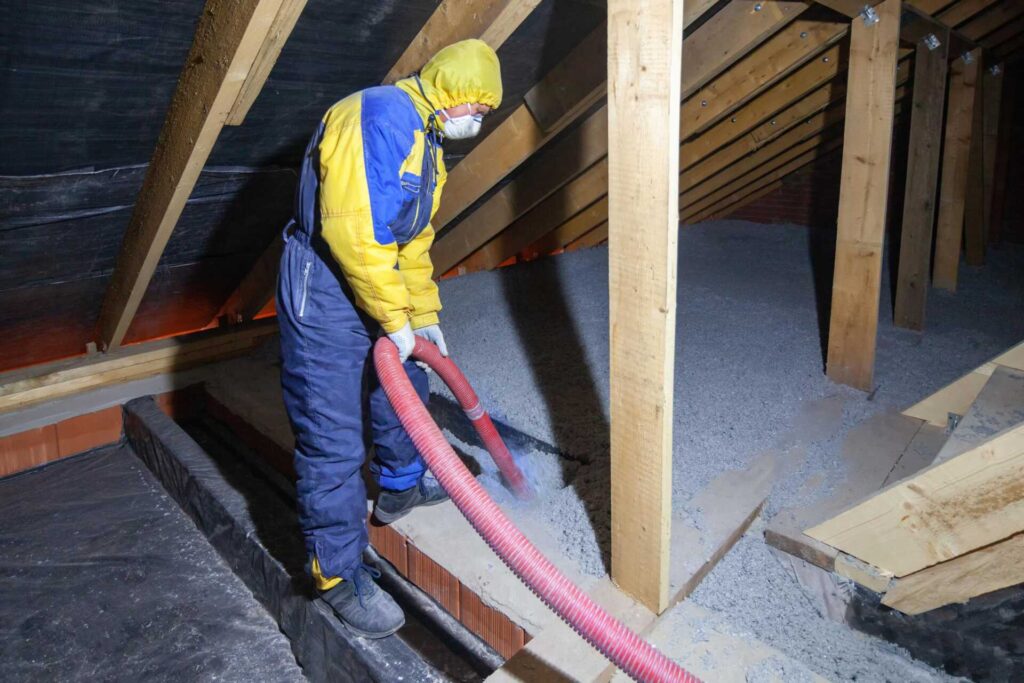
Contents
Did you know that proper insulation can reduce your energy bills? When it comes to blow-in insulation, several options stand out for maximizing those savings. Each material has its own unique benefits, whether it’s the eco-friendliness of cellulose or the superior sealing capabilities of spray foam. As you consider these choices, it’s important to weigh their performance against your specific needs and budget. So, which option will provide the best balance of efficiency and cost-effectiveness for your home?
Key Takeaways
- Cellulose blow-in insulation offers a high R-value for superior energy savings, making it an eco-friendly choice for homeowners.
- Spray foam insulation provides excellent air sealing and moisture resistance, significantly reducing energy bills in both winter and summer.
- Fiberglass blow-in insulation is cost-effective and widely available, suitable for budget-conscious homeowners seeking energy efficiency.
- Mineral wool insulation combines fire resistance and soundproofing, maintaining comfortable indoor temperatures while promoting a healthy living environment.
- Reflective insulation effectively reduces cooling costs in hot climates by reflecting radiant heat, enhancing overall energy efficiency year-round.
Fiberglass Blow-In Insulation
When considering insulation options for your home, fiberglass blow-in insulation stands out as a versatile and efficient choice. This type of insulation offers excellent thermal performance while being relatively easy to install, making it suitable for both new constructions and retrofitting projects.
With the right installation techniques, you can ensure that every nook and cranny is filled, maximizing your insulation’s effectiveness.
One of the key benefits of fiberglass blow-in insulation is its ability to achieve high insulation density. This density is crucial for preventing heat loss in winter and keeping your home cool in summer. By filling gaps and voids, fiberglass blow-in insulation creates a tight barrier against outdoor temperatures, helping you maintain a comfortable living environment.
Moreover, the installation process itself is designed to be efficient and minimally disruptive. Professionals can use specialized equipment to blow the insulation into attics, walls, and other hard-to-reach areas, ensuring a thorough application that might be difficult to achieve with traditional batts or rolls.
Choosing fiberglass blow-in insulation enhances your home’s energy efficiency and contributes to a sense of belonging in a community that values sustainability and comfort.
When your home is well-insulated, you can enjoy lower energy bills and a more pleasant living space, allowing you to focus on what truly matters—creating memories with loved ones.
Consider fiberglass blow-in insulation as a reliable investment in your home’s future.
Cellulose Blow-In Insulation
Cellulose blow-in insulation offers another effective alternative for homeowners looking to enhance their insulation strategy. Made primarily from recycled paper products, cellulose insulation provides impressive thermal performance and boasts significant environmental benefits. By choosing cellulose, you’re participating in a sustainable practice that reduces landfill waste and promotes recycling.
When considering installation techniques, you’ll find cellulose can be blown into walls, attics, and other hard-to-reach areas with relative ease. Professionals often use specialized equipment to ensure a dense, uniform application, which helps minimize air leaks and enhances energy efficiency. This method also allows for retrofitting existing structures without major renovations, making it a versatile choice for many homeowners.
The thermal performance of cellulose is noteworthy; it offers a high R-value, meaning it effectively resists heat transfer. With proper installation, you can experience reduced energy bills and improved comfort year-round. Additionally, cellulose is treated with fire retardants, making it a safe option for your home.
Engaging in the cellulose insulation option benefits your pocket and contributes to a larger community effort in promoting eco-friendly practices. By choosing this sustainable material, you align your home with a growing movement focused on environmental responsibility.
Spray Foam Blow-In Insulation
If you’re seeking a highly effective insulation option, spray foam blow-in insulation could be your solution. This type of insulation offers exceptional thermal performance, sealing gaps, and cracks that standard materials often miss. With its expanding nature, spray foam takes on the shape of your space, providing a tight seal that enhances energy efficiency.
The spray foam benefits are numerous. It prevents air leaks and offers moisture resistance, which can protect your home from mold and structural damage. This dual action makes it a fantastic choice for areas prone to humidity or extreme weather conditions.
Plus, you’ll likely notice a reduction in your energy bills, as spray foam helps maintain a consistent indoor temperature.
In terms of spray foam applications, this insulation can be used in various parts of your home, from attics to crawl spaces. It’s particularly effective in hard-to-reach areas where traditional insulation might fall short.
If you’re considering renovations or building a new home, integrating spray foam blow-in insulation can significantly improve the comfort and energy efficiency of your living space.
Choosing spray foam blow-in insulation benefits your home and fosters a sense of community among those who prioritize sustainability and energy savings. By opting for this advanced insulation method, you’re joining a movement toward more responsible living, ensuring your space is comfortable and environmentally friendly.
Mineral Wool Blow-In Insulation
For homeowners seeking an eco-friendly insulation solution, mineral wool blow-in insulation stands out as a compelling option. This sustainable material, made from natural or recycled fibers, offers several benefits that align with your commitment to energy efficiency and environmental responsibility.
One of the key mineral wool benefits is its exceptional thermal performance. It effectively traps heat in the winter and keeps your home cool during the summer, helping you maintain a comfortable living environment while potentially reducing your energy bills.
Additionally, mineral wool has excellent soundproofing qualities, making it ideal for those wanting to create a peaceful sanctuary in their homes.
Mineral wool installation is relatively straightforward. Professionals can easily blow the material into existing walls or attics, ensuring coverage in hard-to-reach areas. This minimizes disruption to daily life and provides quick results.
The installation is also fire-resistant, adding an extra layer of safety for your family.
Moreover, mineral wool is resistant to moisture and mold, which is crucial for maintaining a healthy indoor atmosphere. By choosing this insulation type, you’re investing in your home’s energy efficiency and the well-being of your loved ones.
Reflective Insulation Options
While many insulation options focus on thermal resistance, reflective insulation takes a different approach by reflecting radiant heat away from living spaces. This innovative method utilizes reflective barriers, typically made from aluminum or other reflective materials, to create a barrier that blocks heat transfer.
When the sun’s rays hit your roof or walls, reflective insulation can effectively redirect that radiant heat, keeping your home cooler in the summer and reducing energy costs.
You might wonder how effective these options are in real-world applications. Reflective insulation is especially beneficial in climates with intense sunlight, where the sun’s heat can significantly impact indoor temperatures. By incorporating this type of insulation, you can maintain a more comfortable living environment without relying solely on air conditioning.
Moreover, reflective insulation is lightweight and easy to install, making it an accessible choice for homeowners looking to enhance their energy efficiency.
When you combine radiant heat reflection with other insulation types, you can create a comprehensive strategy tailored to your specific home needs. This synergy improves energy savings and contributes to a sustainable living space that you can feel proud of.
If you’re considering your insulation options, don’t overlook reflective barriers. They offer a unique solution that complements traditional insulation methods, ensuring that your home remains energy-efficient and comfortable year-round.
Embracing reflective insulation means investing in your home’s future and enhancing your overall quality of life.
Comparing Cost and Performance
When it comes to choosing insulation, comparing cost and performance is crucial for making an informed decision. You want to ensure that the investment in blow-in insulation fits your budget and delivers the energy savings you expect. A thorough cost analysis can help you uncover the upfront expenses and long-term savings associated with different insulation types.
Let’s consider the two main contenders: cellulose and fiberglass. While cellulose might’ve a slightly higher initial cost, its superior thermal performance means it can save you more on energy bills over time. Performance metrics like R-value—how well the material resists heat flow—are essential. Cellulose typically offers a higher R-value per inch than fiberglass, providing better insulation with fewer materials.
Additionally, think about installation costs. Some insulation types may require professional installation, impacting your overall budget. However, if you choose a DIY-friendly option, you could save on labor costs.
Factor in your home’s specific needs and climate; if you live in an area with extreme temperatures, investing in high-performance insulation may pay off in the long run.
Ultimately, comparing cost and performance isn’t just about numbers; it’s about creating a comfortable, energy-efficient home for you and your family. By understanding the balance between upfront costs and ongoing savings, you’ll feel more confident in your insulation choice, fostering a sense of belonging in your energy-conscious community.
Summary
In choosing the right blow-in insulation, think of it as selecting a cozy blanket for your home—each option has its unique benefits tailored to your needs. Whether you prioritize sustainability, cost-effectiveness, or superior performance, there’s an insulation type that fits your goals. By investing in the right insulation, you’re not just enhancing energy savings; you’re creating a more comfortable living space. Take the time to evaluate these options, and you’ll reap the rewards for years.
Recent Posts
Top Attic Air Sealing Techniques for Insulation
Have you ever considered how much energy might be wasted through unnoticed gaps in your
Top 10 Attic Air Sealing Techniques for Insulation
Just as a tightly sealed ship avoids leaks and remains buoyant, your attic’s air sealing
What Are the Best Attic Air Sealing Techniques?
When it comes to attic air sealing, understanding the common leakage points is vital for

